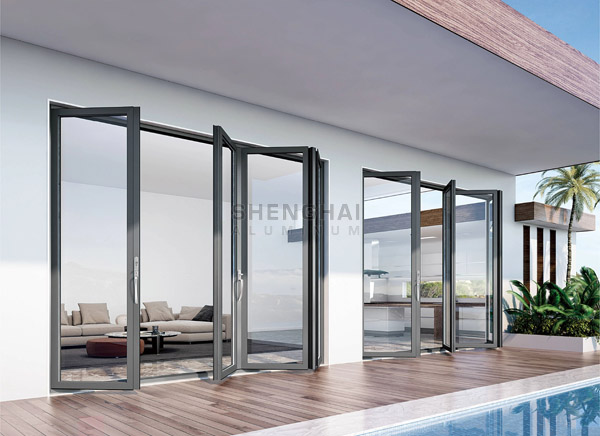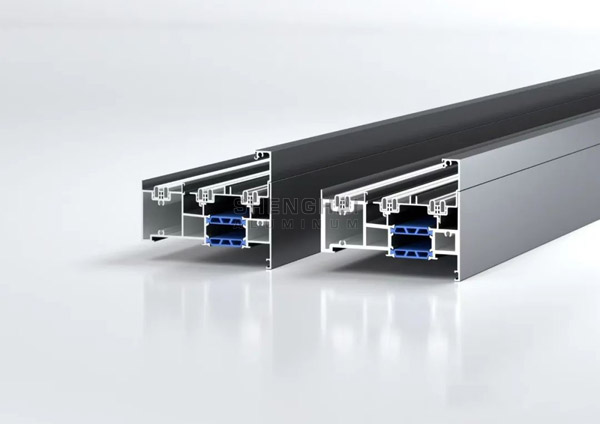Aluminum doors and windows are widely used in residential, commercial and industrial fields in modern buildings due to their superior performance, stylish and beautiful design and low maintenance cost. Its profiles are rich in variety and specifications, which can meet different architectural design and functional requirements. Shenghai-alu will analyze the profile classification, specifications and models of aluminum alloy doors and windows and their practical applications in detail for you to help you better choose the right product.

Classification of aluminum alloy door and window profiles
Casement window profile: suitable for casement window design, with excellent ventilation effect and sealing performance, suitable for environments with high requirements for air tightness and water tightness.
Sliding window profile: used for sliding window structure, easy to operate and save space. Because the window sash slides on the same plane, it is often used in limited space places such as balconies and kitchens.
Top-hung window profile: specially designed for top-hung windows, taking into account ventilation and privacy, does not affect the line of sight and saves space, and is often used in bathrooms, kitchens and other areas.
Curtain wall profiles: used for glass curtain walls or aluminum curtain wall systems, they must have strong load-bearing capacity and wind pressure resistance to meet large-scale building facades’ safety and aesthetic requirements.
Door profiles: used for aluminum alloy doors, including swing doors, sliding doors, etc., with high strength, durability and good sealing performance to ensure safety and comfort.
Shenghai-alu provides you with a variety of specifications of aluminum alloy door and window profiles to meet the needs of different buildings.
Specifications and models of aluminum alloy door and window profiles
The specifications and models of aluminum alloy door and window profiles are mainly divided according to their cross-sectional dimensions and functional characteristics. The following are common specifications and models:
6063-T5: The most commonly used aluminum alloy profile, with excellent extrusion performance and corrosion resistance, widely used in building door and window frames.
6061-T6: Higher strength, excellent corrosion resistance, suitable for load-bearing structural parts and frames.
6082-T6: With both high strength and good processability, it is suitable for building structures, masts and other occasions that require high strength.
In addition, the specific specifications of the profiles also include key factors such as cross-sectional shape, thickness and surface treatment:
Cross-sectional shape: Common ones include U-shaped, H-shaped, T-shaped, L-shaped, etc. Different shapes determine the load-bearing capacity and profile installation method.
Thickness: Generally between 1.0mm and 3.5mm, and the thickness should be selected in combination with the usage scenario and mechanical requirements.
Surface treatment: including anodizing, electrophoretic painting, powder coating, etc. to improve corrosion resistance and decorative effects.
Performance advantages of aluminum alloy door and window profiles
Aluminum alloy door and window profiles have the following excellent properties due to their material properties:

Lightweight and high strength: The density of aluminum alloy is about 2.7g/cm³, which is only one-third of that of steel, but its strength is comparable to that of high-strength alloy steel, which is suitable for construction applications.
Excellent corrosion resistance: The naturally formed aluminum oxide protective film can prevent corrosion, especially in humid environments.
Good plasticity: Various complex sections can be manufactured through extrusion, stretching, bending and other processes to meet different construction needs.
Excellent decorative properties: supports a variety of surface treatments and color options to meet personalized architectural design needs.
Excellent thermal insulation and sound insulation performance: good thermal insulation and sound insulation effects are achieved through reasonable structural design and sealing technology.
Application areas of aluminum alloy door and window profiles
Aluminum alloy door and window profiles are widely used in various types of buildings, mainly including:
Residential buildings: used in living rooms, bedrooms, kitchens, balconies, etc., providing good lighting, ventilation and vision.
Commercial buildings: shopping malls, office buildings, hotels, etc., used for both external windows and internal partitions, with both aesthetics and practicality.
Industrial buildings: factories, warehouses and other environments, due to their high strength and corrosion resistance, they adapt to the special needs of industrial environments.
Public buildings: such as schools, hospitals, libraries, etc., are widely used due to their safety, durability and easy maintenance.
With the advancement of science and technology and the improvement of building energy-saving requirements, aluminum alloy door and window profiles are developing towards higher performance and intelligence:
Intelligent application: integrated intelligent control system to achieve remote control, automatic ventilation, improve energy efficiency and living comfort.
Energy-saving profiles: Develop more efficient thermal insulation aluminum profiles, optimize structural design, reduce heat transfer coefficient, and improve building energy-saving performance.
Environmentally friendly materials: Promote recycled aluminum, reduce carbon emissions, and optimize production processes to reduce environmental impact.
Higher performance standards: Adapt to upgrading building specifications and continuously improve strength, weather resistance, and safety to meet more stringent industry requirements.
Aluminum door and window profiles occupy an important position in modern architecture with their excellent performance and diverse choices. From residential to commercial buildings, from casement windows to curtain walls, it shows unique advantages in different scenarios. With technological innovation and changes in market demand, aluminum alloy door and window profiles are moving towards a more high-performance, multi-functional, environmentally friendly and intelligent direction, providing efficient, durable and beautiful solutions for modern buildings.

